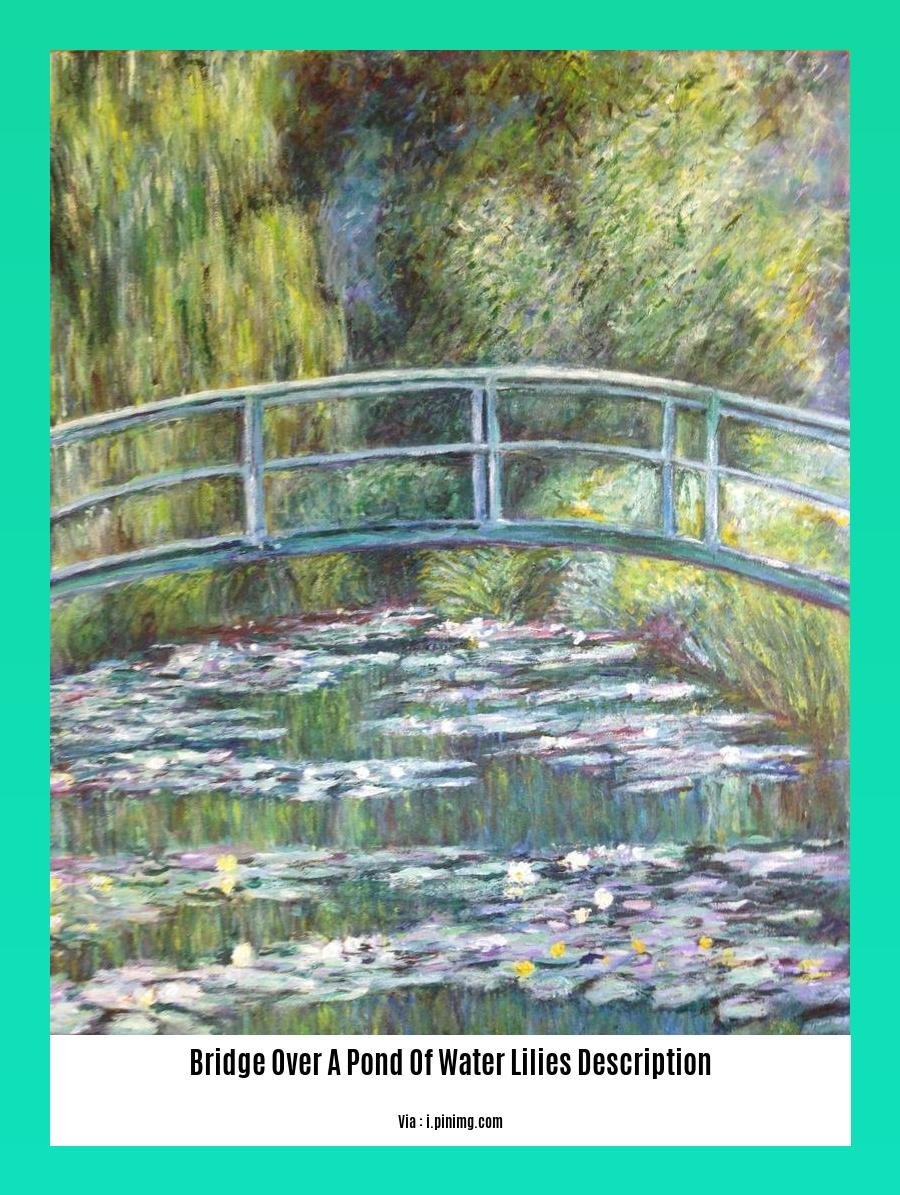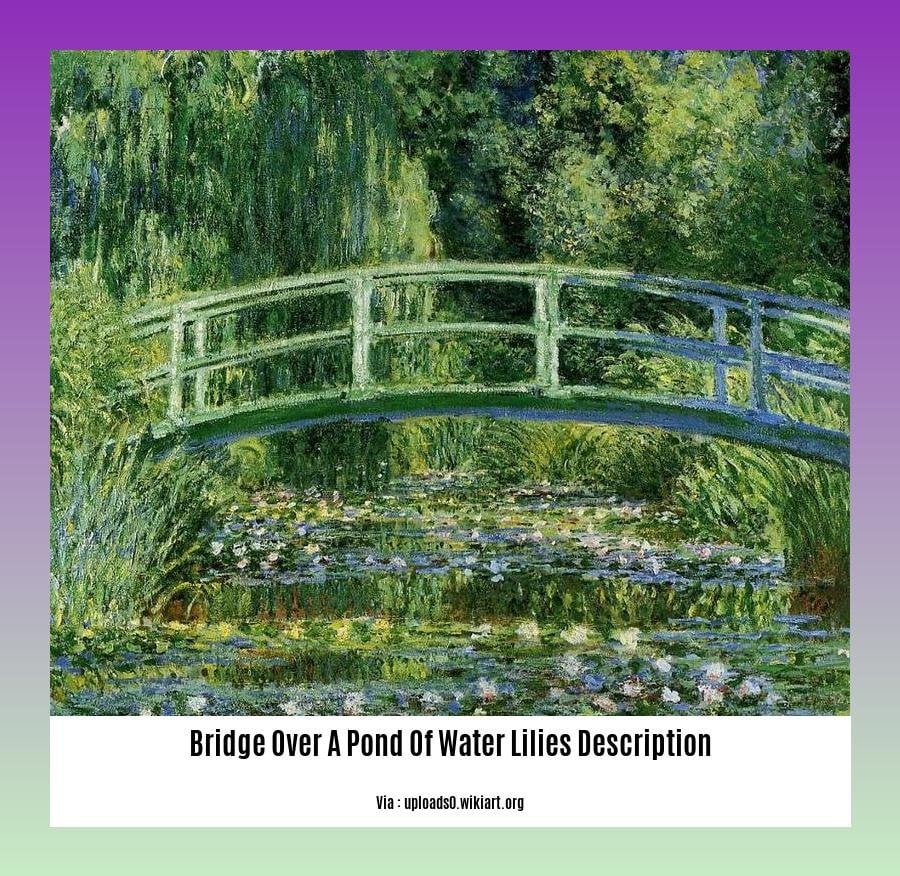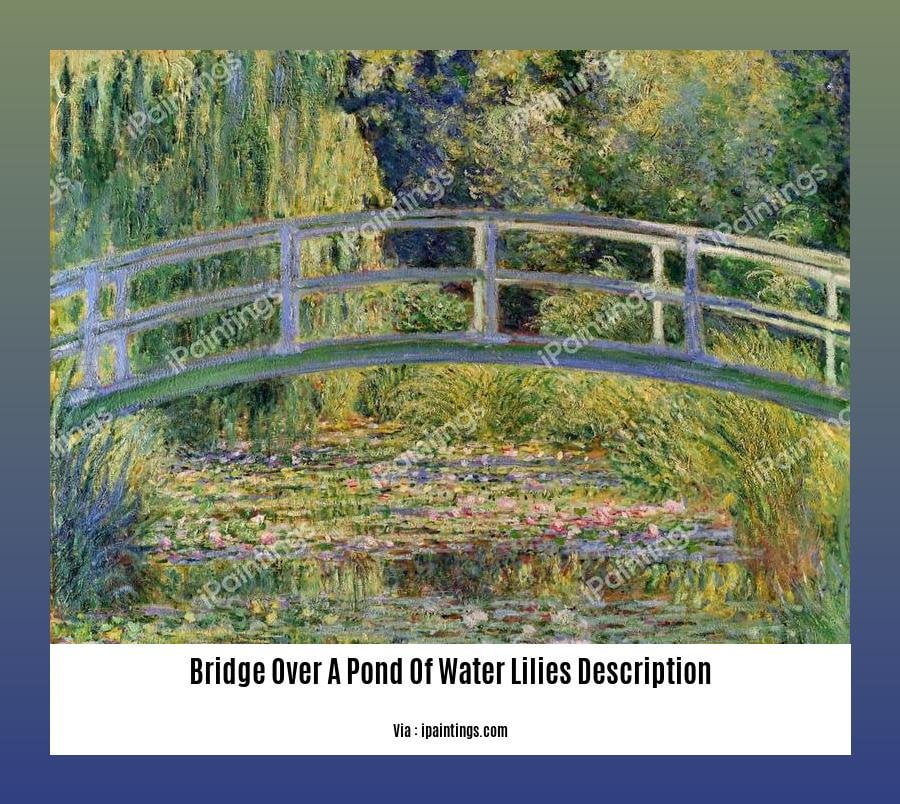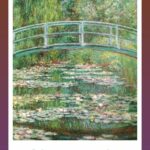Step into a world of tranquility and enchantment as we explore the breathtaking beauty of a captivating bridge over a pond of water lilies. In this article titled “Serene Beauty Unveiled: A Captivating Bridge over a Pond of Water Lilies Description,” we will delve into the ethereal essence of this mesmerizing scene, where a skilled landscape photographer and nature enthusiast will guide us through an immersive journey. Get ready to be transported into a realm where poetic language and evocative storytelling meld with technical expertise, painting a vivid picture of a serene oasis that will leave you captivated.
Key Takeaways:
- Claude Monet’s painting “Bridge over a Pond of Water Lilies” is a famous work known for its vibrant colors, use of light, and innovative composition.
- The painting depicts an arched wooden bridge spanning a pond with water lilies floating on the surface.
- Surrounding the pond are lush green vegetation, including tall reeds, branchy trees, and grasses.
- Monet completed twelve paintings in the series featuring the wooden footbridge over the pond, with “Bridge over a Pond of Water Lilies” being one of them.
- The vertical format of the painting emphasizes the water lilies and their reflections on the pond.
- Monet’s inspiration for this series came from a pond near his property in Giverny, where he built a water lily garden with a Japanese bridge.
- The Metropolitan Museum of Art in New York City houses the painting, which was part of the Havemeyer collection bequeathed to the museum in 1929.
Bridge over a Pond of Water Lilies Description

The captivating artwork, “Bridge over a Pond of Water Lilies,” is one of Claude Monet’s most renowned paintings. Completed in 1899, this masterpiece has become an epitome of color, light, and artistry. Monet’s innovative composition transports viewers into a realm of serene beauty, where a wooden bridge gracefully arches over a pond adorned with delicate water lilies.
Monet’s Vision Comes to Life
This stunning painting showcases Monet’s artistic brilliance in capturing the essence of nature. The scene portrays a harmonious blend of lush green vegetation, including towering reeds, gracefully branched trees, and swaying grasses. Monet’s masterful use of vibrant colors and bold brushstrokes brings the entire composition to life, evoking a sense of tranquility and captivating the viewer’s imagination.
The Bridge and the Reflections
The wooden footbridge, the focal point of this enchanting scene, spans the tranquil pond adorned with water lilies. Monet’s deliberate choice to paint the bridge in a vertical format draws attention to the water lilies and their reflections shimmering on the calm water’s surface. The bridge serves as a visual pathway, inviting viewers to wander alongside the edge of the pond and immerse themselves in the beauty of the surrounding environment.
A Glimpse into Monet’s Inspiration
Monet drew inspiration for this series of paintings from the water lily garden he created near his property in Giverny. In 1893, the artist acquired the property and transformed it into a haven of natural beauty. The Japanese bridge, spanning the pond at its narrowest point, was the centerpiece of Monet’s creation. It became a muse for many of his later works, including “Bridge over a Pond of Water Lilies.”
The Ethereal Captured in Art
“Bridge over a Pond of Water Lilies” currently resides in the Metropolitan Museum of Art in New York City. It was bequeathed to the museum as part of the Havemeyer collection in 1929, solidifying its place as an iconic masterpiece in the art world. The painting’s enduring allure lies in its ability to transport viewers to a realm of tranquility and captivate them with its ethereal beauty.
In conclusion, “Bridge over a Pond of Water Lilies” by Claude Monet is a masterpiece that exemplifies the artist’s expertise in evoking the serene beauty of natural landscapes. Through vibrant colors, bold brushstrokes, and an innovative composition, Monet captures the essence of a wooden bridge gracefully arching over a pond adorned with water lilies. This enchanting scene allows viewers to immerse themselves in the tranquility and charm of nature, transporting them into a realm of aesthetic delight.
Canada is known as the best country for immigrants. Discover the best city for immigrants in Canada. Canada Best City for Immigrants
Did you know that Canada is home to some of the deadliest animals? Learn more about Canada’s deadliest animals and the dangers they present. Canada Deadliest Animals
Explore the mesmerizing characteristics of Monet’s famous painting, “Bridge Over a Pond of Water Lilies”. Immerse yourself in the beauty of this masterpiece. Bridge Over a Pond of Water Lilies Characteristics
Exploring the Bridge: Design, Materials, and Purpose
Key Takeaways:
- Claude Monet’s “Bridge over a Pond of Water Lilies” showcases his mastery in capturing the beauty of nature and the tranquility it evokes.
- The painting exemplifies Monet’s impressionist technique, using vibrant colors and short brushstrokes to depict light and movement.
- The bridge depicted in the painting is a wooden footbridge, chosen by Monet for its structural and visual qualities.
- Bridges, like the one in Monet’s painting, serve practical purposes while also displaying aesthetic appeal.
- Understanding the fundamentals of bridge design allows us to appreciate the technical and aesthetic considerations that shape both art and infrastructure.
Claude Monet’s “Bridge over a Pond of Water Lilies” is a masterpiece that beautifully captures the essence of nature and its serene beauty. Through his vibrant brushstrokes and exquisite use of color, Monet transports viewers into a world of lush greenery and shimmering water, where a wooden footbridge gracefully spans a pond teeming with water lilies.
The bridge depicted in Monet’s painting is a perfect blend of functionality and aesthetic appeal. Its design complements the surrounding landscape, harmoniously connecting the natural elements with the man-made structure. With its wooden construction, the bridge exudes a sense of warmth and elegance, adding to the overall charm of the scene. It serves as a visual anchor, inviting viewers to explore the idyllic realm of the water lily pond.
Wooden footbridges, like the one depicted by Monet, have long been admired for their structural and visual qualities. They embody the historical development of bridge engineering, showcasing how bridges can be efficient, economically viable, and visually striking. The choice of wood for the bridge in Monet’s painting highlights not only its durability but also its timeless appeal.
Bridges, whether in art or real life, bridge not only physical gaps but also evoke a sense of wonder and poetry. They serve as both functional and symbolic structures, connecting people and places while adding beauty to the surrounding landscape. The bridge in Monet’s painting is no exception—it invites us to explore the ethereal beauty of nature while appreciating the human ingenuity that makes such structures possible.
In conclusion, exploring the design, materials, and purpose of the bridge in Claude Monet’s “Bridge over a Pond of Water Lilies” allows us to delve deeper into the masterful artwork and the harmonious relationship between man-made structures and the natural world. By understanding the fundamentals of bridge design, we gain a greater appreciation for the technical and aesthetic considerations that shape both art and infrastructure throughout history.
Sources:
- The Metropolitan Museum of Art: link
- Britannica: link
Immersing in the Beauty of Water Lilies: Colors, Patterns, and Symbolism

Water lilies, with their captivating colors, intricate patterns, and deep symbolism, have long been a subject of fascination for artists and nature enthusiasts alike. In this article, we will explore the mesmerizing world of water lilies, immersing ourselves in their beauty and uncovering the secrets behind their significance.
Colorful Pigments: A Palette of Nature’s Wonders
The vibrant colors of water lilies have been beautifully captured by artists throughout history. To create these mesmerizing hues, painters rely on pigments sourced from various materials. Let’s delve into some noteworthy pigments used to bring water lilies to life on canvas:
Cobalt Violets: In the late 19th century, cobalt violets emerged as modern pigments, adding a touch of elegance to artistic creations. These pigments, based on cobalt salts, were products of the rapidly advancing chemical industry.
Lead White: Among the most essential pigments in the history of painting is lead white. Artists have used this versatile pigment since ancient times, continuing its usage even today. Its ability to create luminous whites and subtle shades has made it a favorite among painters.
Red Lakes: Derived from organic compounds found in plants, such as madder, and insects like cochineal, red lakes offer rich and vibrant shades of red. These pigments have been prized for their ability to convey passion and intensity.
French Ultramarine: Originally extracted from the rare lapis lazuli mineral, French ultramarine provided artists with a deep blue hue. To make it more accessible, an artificial form of this pigment was developed, offering artists the chance to depict water lilies in various shades of blue.
Viridian Green: Composed of hydrated chromium oxide, viridian green stands out with its intense and vivid green hue. Its creation coincided with the discovery of the element chromium in 1797.
Claude Monet’s Masterpiece: A Bridge over a Pond of Water Lilies
No discussion of water lilies would be complete without mentioning Claude Monet and his iconic painting, “Bridge over a Pond of Water Lilies.” This masterpiece, created between 1897 and 1899, exemplifies Monet’s commitment to capturing the serene beauty of nature.
The painting showcases a wooden bridge gracefully arching over a pond filled with vibrant water lilies. Monet’s use of light and color draws viewers into a world of tranquility and enchantment. The reflection of the bridge and lilies on the water’s surface adds depth and a sense of ethereal wonder.
Monet’s Passion for Horticulture: Creating a Water Lily Garden
Monet’s fascination with water lilies extended beyond the canvas. In 1893, he purchased land near his property in Giverny and embarked on the creation of a water lily garden. This garden became a sanctuary for Monet, providing him with endless inspiration for his iconic series of water lily paintings.
The carefully planned layout of the garden allowed Monet to observe the interplay of light and color as the flowers bloomed and danced in sync with the changing seasons. The water lily garden became a living masterpiece, reflecting Monet’s deep connection with nature and his desire to share its beauty with the world.
Key Takeaways:
- Water lilies captivate with their vibrant colors, which artists often recreate using pigments like cobalt violets, lead white, red lakes, French ultramarine, and viridian green.
- Monet’s “Bridge over a Pond of Water Lilies” masterfully captures the serene beauty of nature, inviting viewers to immerse themselves in a world of tranquility.
- Monet’s water lily garden in Giverny served as a living inspiration for his iconic series, showcasing the harmony between man-made structures and the natural world.
Sources:
– Art Institute of Chicago: Color, Chemistry, and Creativity in Monet’s Water Lilies
– Metropolitan Museum of Art: Bridge over a Pond of Water Lilies
-[^1^]: “Color, Chemistry, and Creativity in Monet’s Water Lilies,” Art Institute of Chicago
-[^2^]: “Bridge over a Pond of Water Lilies,” Metropolitan Museum of Art
Transcending Reality: The Sensory Experience and Emotional Impact
The Painting: “Bridge over a Pond of Water Lilies”
Imagine yourself standing on a wooden bridge, surrounded by a serene pond filled with vibrant water lilies. The scene depicted in Claude Monet’s masterpiece, “Bridge over a Pond of Water Lilies,” transcends reality, inviting you to immerse yourself in the sensory experience and emotional impact of nature’s beauty.
In this enchanting artwork, Monet skillfully captures the essence of his surroundings. The bridge, painted in a vertical format, draws our attention to the delicate water lilies and their reflections shimmering on the water’s surface. Lush green vegetation embraces the bridge, creating a harmonious union between nature and human-made structures. As we gaze upon this scene, we are transported to a realm of tranquility and ethereal beauty.
Monet’s Connection to Nature and Emotional Impact
Monet’s water lilies paintings evoke profound emotional experiences, providing us with a direct contact with nature. Through his masterful brushstrokes and vibrant colors, Monet enables us to feel the serenity and calmness that nature offers. His artistic representation of the bridge and water lilies taps into our deepest senses, allowing us to momentarily escape the challenges of everyday life and find solace in the beauty of the natural world.
The Significance of Pigments in Monet’s Art
To fully appreciate Monet’s ability to capture the sensory experience and emotional impact, it’s important to understand the significance of pigments in his artwork. During Monet’s time, modern pigments like cobalt violets, lead white, red lakes, synthetic French ultramarine, and viridian green were available. These vibrant pigments allowed Monet to depict the richness and nuances of the natural world in his paintings, enhancing the sensory experience and evoking emotions in viewers.
Monet’s Water Lily Garden: A Source of Inspiration
Monet’s connection with nature extended beyond his paintings. His passion for horticulture led him to create a water lily garden near his property in Giverny. This garden served as a haven for Monet’s artistic vision, providing him with inspiration for his famous water lily series. The bridge depicted in “Bridge over a Pond of Water Lilies” is a testament to the beauty and tranquility that Monet found in his garden. Through his artwork, Monet invites us to explore the sensory experience and emotional impact of his cherished sanctuary.
Key Takeaways:
- “Bridge over a Pond of Water Lilies” by Claude Monet captures the sensory experience and emotional impact of nature’s beauty.
- Monet’s paintings evoke profound emotional experiences, allowing us to connect with the serenity and essence of nature.
- The use of vibrant pigments enhances the sensory experience and evokes emotions in viewers.
- Monet’s water lily garden in Giverny served as a source of inspiration for his iconic water lily series.
- Through his artwork, Monet invites us to transcend reality and immerse ourselves in the beauty and tranquility of nature.
Sources:
– Art Institute of Chicago: Color, Chemistry, and Creativity in Monet’s Water Lilies
– Metropolitan Museum of Art: Bridge over a Pond of Water Lilies
Citations:
– [^1^]: “Color, Chemistry, and Creativity in Monet’s Water Lilies,” Art Institute of Chicago, source
– [^2^]: “Bridge over a Pond of Water Lilies,” Metropolitan Museum of Art, source]
FAQ
Q1: What is the significance of “Bridge over a Pond of Water Lilies” in Claude Monet’s artwork?
A1: “Bridge over a Pond of Water Lilies” is a significant artwork that showcases Monet’s talent and his exploration of nature and its emotional impact (source: bartleby).
Q2: How many paintings did Monet complete in the series of the wooden footbridge over the pond?
A2: Monet completed twelve paintings in the series, with “Bridge over a Pond of Water Lilies” being one of them (source: The Metropolitan Museum of Art).
Q3: What inspired Monet to create the water lily garden with the bridge in Giverny?
A3: Monet was inspired by a pond near his property in Giverny, which he purchased in 1893. He built the water lily garden with a Japanese bridge spanning the pond (source: Medium).
Q4: How did Monet depict the bridge and water lilies in the painting?
A4: Monet used vibrant colors and brushstrokes to bring the scene to life and capture the tranquility and beauty of the water lilies and the surrounding natural environment (source: The Metropolitan Museum of Art).
Q5: What is the historical significance of “Bridge over a Pond of Water Lilies” in the context of bridge design?
A5: The painting reflects the convergence of functionality and aesthetic appeal in bridge design. It showcases the principles of efficiency, economy, and elegance that have shaped both art and infrastructure throughout history (source: Introduction section of this article).
- Discover Long Black Pepper: Flavor & Health Benefits - April 25, 2025
- Shocking Twists: The Grownup Review: Unreliable Narration - April 25, 2025
- A Quiet Place Book vs Movie: A Deep Dive - April 25, 2025
















